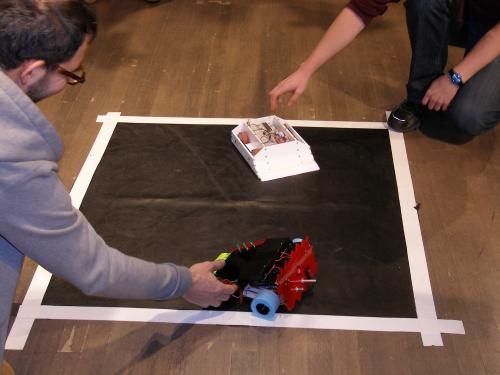Sumo-Robots
Each year the Spring mechatronics (me153) class gives their "final presentation" in the form of a Sumo-Robot competition that pits each team's semester long project against each-other in a battle-royale. The competition, held May 9th this year, was the best attended and the most lively ever. 8 teams fought for the glory of victory, and their final grade.
 Robot sumo has quickly become a popular competition for robot enthusiasts around the world. Each sumobot must attempt to push it's opponent out of the ring before it can be pushed itself. Matches are typically very short and action packed. There are no weapons involved, the robots must rely on brute strength and cunning. This particular competition is completely autonomous, meaning there is no remote control. The robots must think for themselves, identify the "edge of the ring" by color alone and avoid it - all while attempting to find it's opponent and push it.
Robot sumo has quickly become a popular competition for robot enthusiasts around the world. Each sumobot must attempt to push it's opponent out of the ring before it can be pushed itself. Matches are typically very short and action packed. There are no weapons involved, the robots must rely on brute strength and cunning. This particular competition is completely autonomous, meaning there is no remote control. The robots must think for themselves, identify the "edge of the ring" by color alone and avoid it - all while attempting to find it's opponent and push it.
Just some of the topics covered in the class include combinational digital logic, computer architecture, embedded controller programming, systems engineering and project management. The class is a junior year mechanical engineering elective, and is structured to introduce the students to the concepts of "mechatronics". Prof. Brian Cusack has been teaching the class for the last 9 years, and has used robot-sumo as a term project for the last 7. Teams of 3 are required to design, from scratch, their own sumo robot and take that design from sketch to competition ready robot in 14 weeks. "I could have the students design lab experiments but building fighting robots adds a level of excitement and enthusiasm to the project that helps reinforce the topics covered in the class. The students think of it as the class they get to build a robot in, but they are learning about sensors, control systems, drivers, programming, prototyping and so much more. In essence they have built mobile data acquisition microcomputers that process that data and give a control response. One of the biggest lessons is the project management required to do all this in a very short period of time. Week 1 is brainstorming, by week 2 I expect sketches of a "final concept". By week 3 I expect CAD drawings of that design and I expect parts received, machined and assembled a few weeks after that... The semester moves fast, and the only path to success to careful planning, execution, and evaluation of progress."
"This year "NinjaCat" (Spyros Korsanos, David Rophael, and Michael Sanfelice) went undefeated to win a flawless victory, but every team arrived at the competition with a functional competition-ready robot (a big success in my book). In fact one of the coolest stories happened behind the scenes minutes before competition started. One team crossed a wire and blew up (literally) their microcontroller. I handed them the key to my office and said "get a new microcontroller, program it, rewire it, and be back in 25 minutes". They were back in 20 - with a functioning robot. I wager those 20 minutes were more stressful than any other final they had this year, but they passed this one with flying colors."

